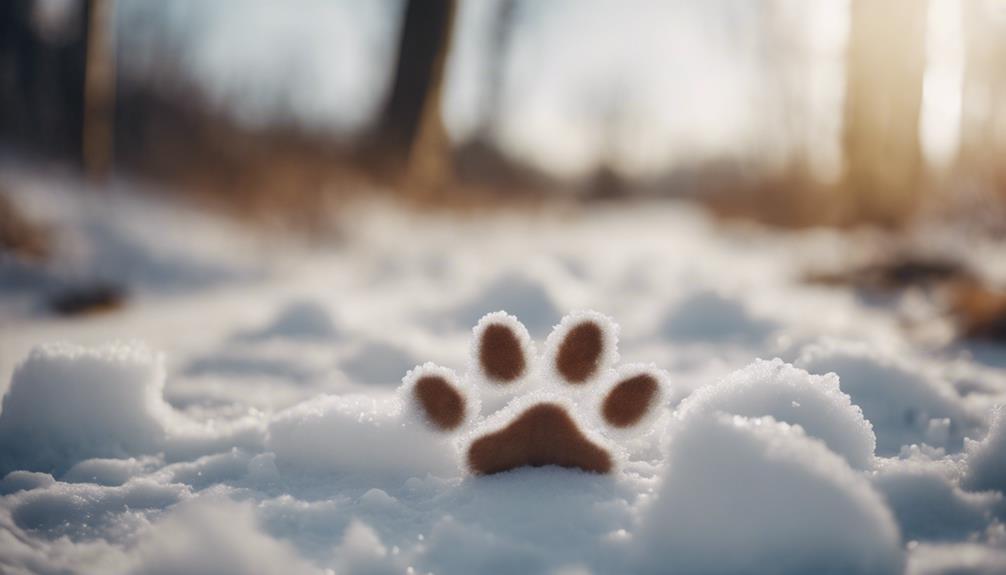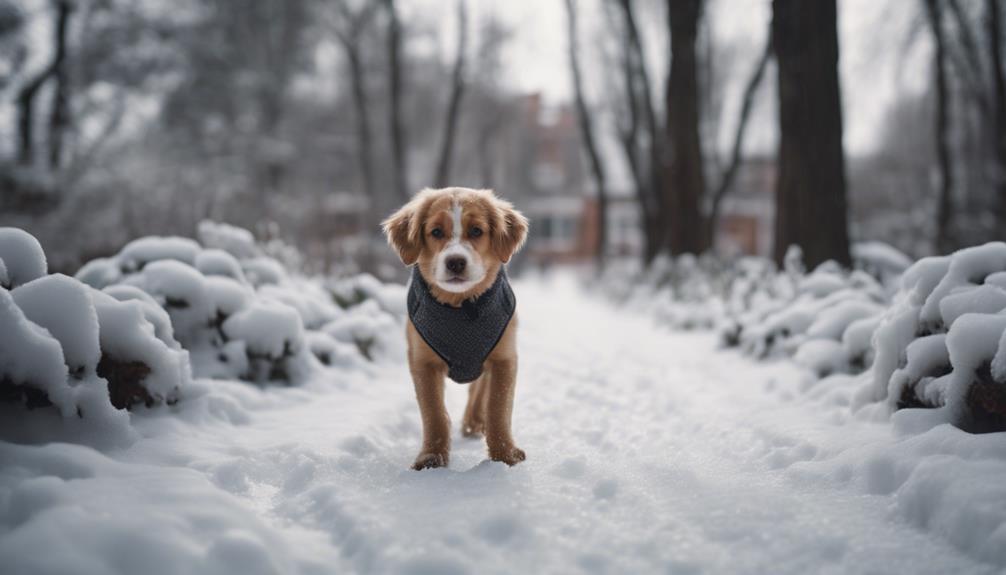As winter sweeps in, pet owners face the challenge of safeguarding their furry companions' paws from the unforgiving elements of snow, ice, and salt. With the dropping temperatures and icy conditions, ensuring your dog's paw health becomes a critical aspect of their overall well-being.
By implementing a few key strategies and adjustments to your routine, you can significantly reduce the risks associated with winter-related paw injuries.
Stay tuned to discover the essential ways you can protect your dog's paws and keep them safe and comfortable throughout the chilly season.
Key Takeaways
- Use dog booties and paw balm to shield paws from winter hazards.
- Opt for pet-safe ice melt to protect dogs from harmful chemicals.
- Limit outdoor time and groom paw hair regularly for optimal paw health.
- Clear pathways, clean paws post-walk, and prioritize paw care in winter.
Proper Footwear for Paw Protection
When considering paw protection for your dog in winter, selecting the appropriate footwear, such as dog booties, is crucial in safeguarding their paws from cold weather elements. Dog booties serve as a protective barrier against rough surfaces, ice, and salt, preventing cuts, dryness, and injuries recommended by veterinarians. These boots help maintain paw temperature, ensuring overall safety during winter outdoor activities.
Nourishing Paw Care Products
To further enhance your dog's paw health and protection during winter, incorporating nourishing paw care products is essential for maintaining their paw pads' moisture and resilience.
Here are three nourishing paw care products to consider:
- Paw Balm: Formulated to moisturize and shield paw pads, providing relief from irritation and preventing cracks.
- Petroleum Jelly: Offers a protective barrier for paw pads, complementing booties for optimal care and moisture retention.
- Moisturizing Paw Cream: Specifically designed to hydrate and nourish paw pads, essential for combating dryness and maintaining paw health in varying winter conditions.
Safe Ice Melting Alternatives

Exploring environmentally friendly options for ice melting solutions in winter presents an opportunity to safeguard your dog's well-being during outdoor activities.
Homemade pet-safe ice melt provides a non-toxic alternative to store-bought products. This solution effectively protects dogs from harmful chemicals, ensuring a slip-free environment while maintaining the safety of your pet.
By opting for homemade alternatives, you can prevent your dog from ingesting dangerous substances often found in commercial ice melts. This method is ideal for maintaining walkways without posing a risk to your furry companion's health.
Prioritizing safe ice melting alternatives is crucial in creating a pet-friendly winter environment that promotes both safety and well-being for your beloved canine friend.
Strategic Outdoor Activity Management
In ensuring the well-being of your dog during winter, strategic outdoor activity management plays a pivotal role in maintaining their safety and comfort.
- Short Walks: Limiting the duration of walks helps prevent snow, ice, and salt buildup on paws, reducing discomfort and potential injuries.
- Body Heat Retention: Short walks are particularly beneficial for smaller breeds, aiding in preserving their body heat and minimizing the risk of hypothermia.
- Extreme Cold Awareness: It is advisable to be mindful of extreme cold weather conditions and to adjust outdoor time accordingly to ensure your dog's safety and well-being.
Post-Walk Paw Maintenance

After outdoor walks during winter, ensuring proper care for your dog's paws is essential to maintain their health and comfort. Cleaning your dog's paws immediately after walks is crucial to remove snow, ice, and salt residue. This practice helps prevent irritation and potential ingestion of harmful chemicals, especially for dogs exposed to ice melt.
By using a gentle paw wash or simply wiping their paws with a damp cloth, you can promote paw health and cleanliness after winter outings. Additionally, inspecting their paw pads for any signs of cuts, cracks, or redness is important for early detection of issues.
Post-walk paw maintenance is a simple yet effective way to ensure your dog's paws stay healthy and protected throughout the winter season.
Grooming Tips for Paw Health
To ensure comprehensive care for your dog's paws throughout the winter season, proper grooming techniques play a vital role in maintaining their health and protection. Grooming not only keeps your furry friend looking tidy but also contributes to their overall well-being. Here are some essential grooming tips for paw health:
- Regular Paw Hair Trimming: Trim the hair around your dog's paws to reduce ice accumulation, prevent the formation of painful ice balls, and facilitate easier cleaning.
- Nail Maintenance: Keep your dog's nails trimmed to an appropriate length to prevent them from getting caught in icy surfaces or causing discomfort while walking.
- Moisturizing Paw Pads: Apply paw balm or petroleum jelly to keep your dog's paw pads moisturized and protected from harsh winter conditions.
Yard Safety Measures

Enhance your dog's outdoor experience by implementing strategic yard safety measures to safeguard against winter hazards. Clear pathways for easy access during potty breaks to prevent snow buildup.
Utilize pet-safe ice melt on walkways to avoid slips and protect your pet's paws from harsh winter conditions. This is particularly important for dogs with health conditions like arthritis; consulting a vet for personalized advice is advisable.
Conclusion
In conclusion, safeguarding your dog's paws from the harsh effects of snow, ice, and salt during the winter months is essential for their well-being.
By utilizing protective gear, incorporating nourishing paw care products, using safe ice melting alternatives, managing outdoor activities strategically, practicing post-walk paw maintenance, following grooming tips, and implementing yard safety measures, you can ensure optimal paw health for your furry companion throughout the winter season.




